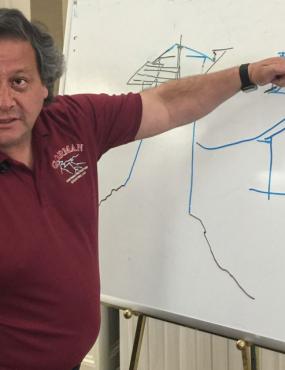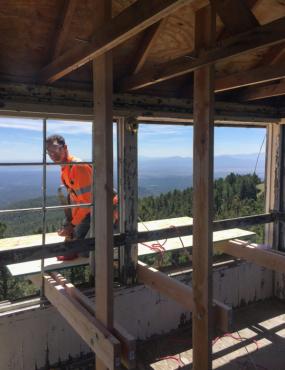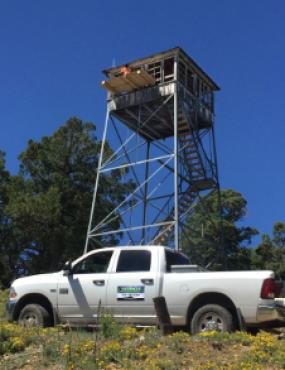Lightning protection installers hang out in high places, including the apex of tall chimneys, radio antennas, and church steeples. Lightning protection systems in these exposed locations have to extend to the highest parts of the structures so the system can intercept lightning strikes before the lightning reaches the structure. To reach these rarefied heights, it is all in a day’s work for an installer to dangle from ropes, erect scaffolding, or use telescoping boom lifts. Occasionally, however, an installer has to think outside of the box.
Consider, for example, a box reaching 45 ft. above a steeply-sloped grade atop a tall spindly fire lookout tower looming above a 10,220 ft. peak at the end of a long drive on an extremely rough and rocky ungraded dirt road in the middle of a wilderness mountain range.
That’s the challenge confronted by Gorman Lightning Protection and Electric of Santa Fe, NM when asked to install a lightning protection system at the Glorieta Baldy Fire Lookout Tower in the Sante Fe National Forest. The tower was constructed during 1939 and 1940 then retired from service in the 1990s. The historic tower is now being restored by Friends of the Santa Fe National Forest for use as an overnight accommodation as part of the US Forest Service’s cabin and lookout rental program.
The remote location and unique site conditions made it impractical to use conventional means of access to the roof. After considering alternatives, Jay Gorman, a partner in the firm, and his crew engineered work platforms supported on outriggers cantilevered through open windows of the lookout cabin.
According to Jay, “The amazing view from the top could have been distracting to the installers. Yet our attention was on working safely and making sure the air terminals were properly secured at the peak of the hipped roof and its four corners.” He explains the air terminals were mounted on through-structure penetrations. Under the roof, the penetrations were connected via short lightning conductor cables to the tower’s 1/2” thick steel framing that functioned, in turn, as lightning down conductors. Jay notes, “the ground was rocky, so instead of driving vertical grounding rods, we used two ground plates buried about 30-inches deep in patches of decent soil.”
Once the renovations are complete, the cabin will be a life-saving refuge for guests caught in the frequent electrical storms that sweep through the area. While a tower on a mountaintop is clearly at risk of lightning damage, lightning is just as dangerous in the valleys and flat lands below. As Jay reminds people, “When thunder roars, go indoors!”
Our Partner:

visit www.sls-us.com to learn about their suite of lightning solutions for special applications




